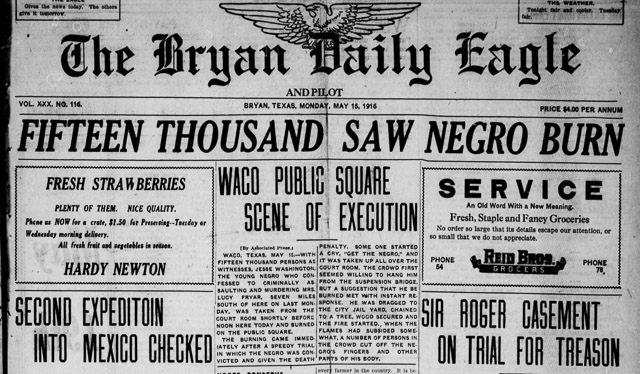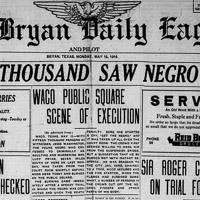 Bryan Daily Eagle and Pilot, May 15, 1916
Bryan Daily Eagle and Pilot, May 15, 1916
My Social Studies Methods class at the University of Portland recently published a free multi-touch iBook – Exploring History: Vol III (free iTunes). It features thirteen engaging questions and historic documents that empower students to be the historian in the classroom. For more info on our project and free download of multi-touch iBook and pdf versions click here. To better publicize student work, I’m featuring each chapter in it’s own blog post. (Third of 13)
The Waco Horror by Alekzandr Wray
Download as PDF 2MB
The 1916 lynching of Jesse Washington, a 17 year old African American man from Waco, Texas, was one of the most heinous acts of government sanctioned mob “justice” in American society. The barbarity of the act, the festive/jovial/family-centered nature of the event, the sheer volume of participants, and the local government inaction around the incident shocked many people in the nation and spurred the NAACP to take immediate action around Anti-Lynching Legislation. Jesse Washington was just one of thousands of stories but we will focus on primarily on his today and the context surrounding lynchings in the early 20th century.
Reflection by Alekzandr Wray:
Throughout the entire process of creating my document based lesson I was incredibly engaged. The idea of setting up students to serve as historical detectives was fascinating and doing the research to “uncover” primary sources/information proved incredibly fruitful and fulfilling. I even felt like a historical detective at certain points, especially when the Schomburg Center for Research in Black Culture emailed me the court transcripts from Jesse Washington’s “trial” in Waco, Texas!
Focusing on the lynching of Jesse Washington was certainly a emotionally/spiritually challenging task for me, however, and I initially struggled with the idea of what I wanted students to actually do with this information and what my intention for the lesson was. “Do I want students to get angry over Jesse Washington’s lynching and just sit in that anger? Do I want students to see how groups like the NAACP rose to prominence because of the work they did to quell lynchings? What am I trying to get at?” Ultimately, I ended up deciding that my intention was multifaceted… I am totally fine with students getting upset over historic injustices (after all, who learns about events like the Holocaust or Jim Crow and DOESN’T get upset?) because I believe that will ignite an inner fire/passion to fight against present day injustices and, of course, I want students to feel empowered in their ability to contribute to society for the better so I felt the need to highlight the NAACP’s article in “The Crisis” and Billie Holiday’s “Strange Fruit” as examples of resistance.
I truly appreciated this process and wish I had more opportunities to engage in document based learning during my secondary education career. I fully intend on utilizing this type of lesson in my future classroom in sha Allah.
If anybody who reads my chapter on Jesse Washington and the dark legacy of American lynchings has any feedback or recommendations, I would love to hear from you. Please feel free to contact me on LinkedIn. Much obliged.
Image Credit: Bryan Daily Eagle and Pilot, May 15, 1916
Library of Congress

